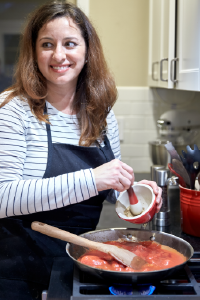
Dear Internet,
If you are not familiar with any of the dietary requirements outlined in SooN COOKING, you may find what you need here. SooN’s Dietary Restriction Decoder is simple:
- Diet Name
- The critical details
- What’s on the “DO NOT SERVE” list
- Diet Deep Dive
- More Information
Now. This is my interpretation. It will give you the general idea of the dos and
To tackling Meal Planning FUD!
Bon Appétit,

New to SooN COOKING?
For a food blog, I know the approach is unconventional. There are two very specific reasons why. Click here to find out more.
Anchor
The Celiac Diet
The Critical Details
This is a medical based diet which mainly excludes gluten and soy products.
What’s on the ” Do Not Serve” List
- Barley, specifically the Hordein protein
- Beer
- Brewer’s yeast
- Malt
- Oats, specifically the Avenin protein
- Packaged foods not
labelled gluten-free - Rye, specifically the Secalin protein
- Starch (it’s basically SUPER gluten)
- Triticale (a rye and wheat hybrid)
- Wheat, specifically the Gliadin protein
Diet Deep Dive
According to the Celiac Disease Foundation, Celiac Disease is an autoimmune disease which impacts about 1% of the population and causes damage to the small intestine. People with Celiac Disease are unable to absorb gluten which is a substance found in grains like barley, rye
More Information
Anchor
The Halal Diet
The Critical Details
What’s on the “DO NOT SERVE” list
- Pork
- Anything that will alter your state of mind like alcohol or drugs.
- Birds of prey
- Carnivores
- Blood
- Carrion
Diet Deep Dive
So in addition to avoiding anything Haram, all Halal foods must be prepared in accordance with these specific guidelines:
1. When a Halal animal is butchered, it must be slaughtered following Islamic law. According to the Guardian, that means, “The animal has to be alive and healthy, a Muslim has to perform the slaughter in the appropriate ritual manner, and the animal’s throat must be cut by a sharp knife severing the carotid artery, jugular vein and windpipe in a single swipe. Blood must be drained out of the carcass.”
2. The end-to-end processing of Halal foods must be completely free of anything Haram. This starts with the ingredients themselves, includes the cooking techniques, manufacturing equipment and storage containers.
3. To add more color to #2, Halal foods must not be contaminated by Haram foods. For example, after sautéing a chicken breast you could not deglaze the pan with white wine and then use that in a sauce to pair with the chicken. Alcohol is Haram, so hopefully it is clear why this would be forbidden.
Again, this information is based purely on internet research. I do not follow a Halal diet, nor have I ever cooked for someone who does. PLEASE provide feedback if I am inaccurate with my Halal guidance so I can correct it!
More Information
Anchor
The Kosher Diet
The Critical Details
Looking for Something?
Search SooN LIVING and let us know if you don't find what you are looking for!
What’s on the “DO NOT SERVE” list
Now. The main rule to follow is NO MIXING MEAT WITH DAIRY. This rule is as important to Judaism as NO SEX BEFORE MARRIAGE is to Catholicism. Since I am a Cashew, I feel it is KOSHER for me to say that NO MIXING MEAT WITH DAIRY is essentially the CARDINAL RULE of Kosher eating.
Got it? Great. So now you need to categorize your food selections into one of three categories:
1. MEAT: This is defined by the flesh or byproducts (like bone broth) from a Kosher animal or bird.
2. DAIRY: This is defined by the milk or products made from milk (like cheese) from a Kosher animal.
3. PAREVE (or PARVE): This is defined by food that is neither meat or dairy. I find it helpful to think of foods in this category as “neutral”. Examples are fruits, vegetables, grains, nuts, beans, legumes, water, coffee, and tea. Fish and eggs are also PAREVE (which I find extremely useful when cooking with dairy).
Stay with me! Next, you need to make sure the food you have selected is NOT on an exclusion list:
- MEAT: Meat from animals that do not chew their cud AND have split hooves is forbidden. Pigs and rabbits are NOT Kosher while cows, lambs, goats are examples of Kosher animals.
- BIRD: Birds of prey such as an eagle are NOT Kosher. The bird must also have an extra toe, crop or peelable gizzard to be Kosher. Examples of Kosher birds include chickens, ducks, and quails. Remember that birds also fall into the “meat” category.
- DAIRY: Dairy follows the transitive property − meaning, milk or products made from milk that is derived from an animal that is NOT Kosher are also NOT Kosher. Therefore, if you have dairy from a Kosher animal then it is also Kosher!
- FISH: Fish that do not have fins, scales and gills such as shellfish are NOT Kosher. Salmon, Tuna and Cod are examples of Kosher fish.
Ok, so POP QUIZ! A cheeseburger is:
a) NOT Kosher
b) Kosher
If you answered “b”, my immediate thought is, “Oy Vey”. But I recognize that that isn’t helping you either. I think you should write down the Cardinal rule: MEAT + DAIRY = NEVER.
Almost there! Understanding what makes something Kosher isn’t limited to WHAT it is. It also includes HOW it is processed. So in addition to avoiding anything NOT Kosher, all Kosher foods must be prepared in accordance with these specific guidelines:
The end-to-end processing of Kosher foods must be completely free of anything NOT Kosher. This starts with the ingredients themselves, includes the cooking techniques, manufacturing equipment and storage containers.
The slaughtering process must follow this formula: Shechitah (kosher slaughter) = shochet (trained, certified AND Jewish slaughterer) + challef (very sharp and long knife). Following the slaughter, the meat is closely inspected by a bodek (trained, certified AND Jewish inspector). If the Bedika (inspection) does not reveal any physiological abnormalities, then the meat moves onto the removal of any blood. This is done by either soaking, salting or broiling the meat. Once this has been completed it is packaged and labeled as Kosher!
Kosher foods must not be contaminated by non-Kosher foods which I’ve come to think of in the following ways:
It does not combine MEAT and DAIRY. (Obviously, Cardinal rule!)
If it is MEAT, it is first not on an exclusion list and is next butchered following a Kosher process. This includes keeping the Kosher MEAT separate from anything that is NOT Kosher.
If it is DAIRY, it is first not derived from an animal that is on an exclusion list and is next processed following Kosher law. This includes keeping the Kosher DAIRY separate from anything that is NOT Kosher.
If it is PAREVE, it is (you guessed it!) first not on an exclusion list and is next processed following a Kosher process. This includes keeping the item separate from anything that is NOT Kosher.
Almost there! I know there is a lot to “digest” about Kosher law. The easiest way to keep sane while trying to make sure your meal is staying Kosher is to do Q&A with yourself using these two questions:
Q: What type of food is it?
A: Categorize it ONCE as either MEAT, DAIRY, or PAREVE.
Q: When can a Kosher person eat it?
A: There is a lot of fine print to consider when answering this one. Just remember not to:
-
Mix MEAT and DAIRY
-
Pick something from the EXCLUSION list
Diet Deep Dive
Ok. So there are really only two more things that I want to tell you about keeping Kosher:
1. It is important to note that when you pair a PAREVE item with either a meat or a dairy item, the PAREVE item takes on the paired item’s category. For instance, if you are serving steak and you pair it with roasted potatoes, you could not then take any leftover potatoes and then pair that with sour cream or cheese. The potatoes became MEAT when you paired them with the steak. To add DAIRY to the leftover potatoes would be a violation of the Cardinal rule (MEAT + DAIRY = NEVER).
I said this in the beginning but that was so long ago that you may have forgotten…A lot hangs on your guest’s level of observance so review your meal strategy with them to confirm it meets their needs. Specifically ask them if you should use disposable products to cook and serve your food. Why is this important? Take my Aunt Maxine (who is an Orthodox observer). She has separate kitchens for MEAT and DAIRY in her home. That’s ONE set of pots, pans, utensils and dishes PLUS a separate sink, oven, refrigerator and dishwasher TIMES TWO. So if she came to my non-Kosher house for dinner where I frequently cook and eat meat+dairy AND shellfish AND pork on my ONE set of pots, pans, utensils and dishes. Even if I have purchased a nice piece of Salmon (PAREVE), it would become NOT Kosher when I cook it in my kitchen and serve it on my plates.
The solution? Tinfoil, paper plates and plastic utensils!!!
More Information
Anchor
The Vegetarian Diet
The Critical Details
What’s on the “DO NOT SERVE” list
- VEGAN: Vegan is the purest vegetarian diet. There is no meat, poultry or fish. Anything derived from meat, poultry or fish, such as broth, is excluded. Animal by-products like dairy, eggs, or honey are also not consumed by vegans.
- LACTO VEGETARIAN: Lacto = milk. This diet allows for dairy products but excludes meat, poultry and fish. Anything derived from meat, poultry or fish, such as broth, is excluded. Eggs are also not consumed by Lacto Vegetarians.
- OVO VEGETARIAN: Ovo = egg. This diet allows for eggs but excludes meat, poultry and fish. Anything derived from meat, poultry or fish, such as broth, is excluded. Dairy is also not consumed by Lacto Vegetarians.
- LACTO-OVO VEGETARIAN: Dairy and eggs are in! But meat or anything derived from meat is excluded.
- POLLOTARIAN: Pollo = chicken. This diet allows for chicken and eggs. It excludes meat and fish or anything derived from meat and fish.
- PESCATARIAN: Pesce = fish. This diet excludes meat and poultry and anything derived from meat and poultry including eggs.
Diet Deep Dive
1. Health: A vegetarian diet can help with weight-loss, heart disease, type 2 diabetes and cancer prevention.
2. Religion: Buddhism, Hinduism, and Jainism are examples of religions that mandate or advocate for vegetarianism.
3. Animal Rights: Following a vegetarian diet means abstaining from the cruelty, pain and exploitation of animals who are raised, farmed and slaughtered as a result of animal production.
4. Environmental: According to The United Nations livestock (for meat and dairy) “generates more greenhouse gas emissions as measured in CO2 equivalent – 18 percent – than transport. It is also a major source of land and water degradation. ”
More Information
Feedback? Input? Questions?
We cannot wait to hear from you!


0 Comments